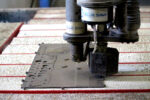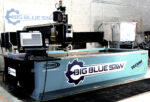While earning his keep as a freelance IT consultant, Simon Arthur began designing and building robotic war machines, or “battle bots,” and entering them in contests around the country. As he grew to know other enthusiasts he found they shared a problem he’d encountered himself: locating dependable suppliers of the custom-designed parts they required, with a reasonable lead time and cost for small-quantity orders. Arthur recognized a market in terms of “need,” but no existing structure to support and define such an enterprise.
That’s when his IT training kicked in. Instead of focusing on the part, as an engineer probably would, he began by imagining the system that could make this happen – what types of services should be offered, and how would order specifications be submitted? Building a strong network of specialty service contractors – laser and water jet cutting, primarily, which the battle bots required most – would take time, and then the years of effort it would require, with no marketing budget, to build a customer base working the crowd at battle bot events. Arthur began developing the software for the company, which he’d decided to name Big Blue Saw, located near Atlanta, Georgia, in 2005, launching soon after.
Arthur graduated from his home into a small office space in 2014, going full-time with the company and soon hiring additional employees. The majority of their work was subcontracted, Customers were drawn to a website that organized and simplified their needs, allowing complete design prints to be uploaded and providing assistance to those requiring polishing, whether the order called for one or 10.000 parts. The company made its last significant move in 2019, gaining more production space and equipment for both its laser and water jet cutting divisions. He quickly found that equipment service was a primary concern in his line of work,
“Rather than focusing on the brand to impress potential customers, I found it was more important to identify OEMs that took maintenance response seriously,” Arthur says. “If you’re looking at a water jet, for instance, the whole system is under extreme pressure, and something can blow at any time.
Expanded space was required because Big Blue Saw, as expected, had begun to pull in subcontracted work so they could begin performing as many operations on site as possible. Since that decision was made, 90-percent of production takes place under-roof, leaving only a small portion of specialty operations currently being subcontracted,
The two processes allow for cutting a broad range of materials. Water jet cutting, for example, is ideal for aluminum, stainless steel, titanium, copper, and brass, while laser easily handles wood, rubber, and acrylic.
Nothing has been abandoned while these gains have been made, though, Arthur says: “All of our customers were hobbyists in the early years. They were just excited to find a site where they could get the custom parts they needed quickly, easily, and at a reasonable cost. So they remain a central part of our business, as they will.”
At the same time, Big Blue Saw has expanded its horizons, collaborating with NASA’s Jet Propulsion Laboratory (JPL) and Microsoft, for instance, leading a field of big-name enterprises attracted to the company’s business model and output. Its roots remain intact, however, as Big Blue Saw will be sponsoring four teams at BattleBots 2021 in Las Vegas this August, which will be broadcast on The Discovery Channel.
It’s long been said that if you can find a way to make a living doing some you truly enjoy, then you’ve really accomplished something. And that can surely be said for Simon Arthur and his colleagues at Big Blue Saw.






















